In the age of TikTok and Instagram Reels, short-form content is king. But creating that perfect viral video can feel like catching lightning in a bottle. Whether aiming to boost your brand or entertain, finding the right video content creator tools can be a game-changer. This guide will help you through the best options, helping you craft those scroll-stopping clips everyone talks about.
Crayo AI's clip creator tool is a standout solution you'll want to know about. It's designed to help you create viral short videos easily, making your content engaging and widely shareable.
Table Of Contents
What Is A Video Content Creator?

A video content creator produces videos for various platforms. Their work involves planning, scripting, shooting, and editing videos. You’ll find these creators’ work on TV and billboards, but most of it is now online. They often collaborate with social media content creators and online marketers.
Where Can You Find Their Work?
Video creators are everywhere you look. While traditional media like television and billboards still feature their work, today’s video creators mainly focus on online platforms. As a result, they often collaborate with social media content creators and online marketers. This helps them reach larger audiences and create engaging content.
Who Do They Work For?
Video creators may work for businesses or independently. Those employed by businesses often create promotional videos, including product showcases, company profile videos, and customer testimonials. Independent creators produce content to entertain or educate their audiences. They may make how-to guides, documentaries, and other insightful content.
How To Be A Video Content Creator In 6 Simple Steps

1. Find Your Niche
Picking a niche means narrowing your focus to a specific topic for your content. This helps you connect with an audience that shares your interests. Aim for something you’re passionate about to keep the process enjoyable and authentic.
Action
Research popular niches and note trending topics in your areas of interest.
Once you've picked a niche, immerse yourself in it. Learn the themes, language, influencers, and recent developments. Essentially, become part of that community.
Look for unique angles you can explore in your content strategy.
2. Understand Your Audience
Knowing who you want to attract with your video content allows you to tailor everything to their tastes. This includes the types of content they prefer, how they interact with videos, and even the best time to publish.
Action
Define your ideal viewer. What are their age, interests, and location? What content do they consume?
Use tools like Google Trends and social media analytics to gather data about your target audience.
Conduct surveys or polls to directly ask your viewers what they prefer.
3. Establish Your Brand
Your brand differentiates you from other creators and includes your visual style, tone, and message. A strong brand makes your content recognizable and can foster community among viewers.
Action
Develop a clear brand strategy. What values or messages do you want to communicate?
Visually represent these ideas with a distinct style, catchphrases, or specific themes in your content.
4. Produce High-Quality Content
High-quality content is engaging, well-produced, and provides value to the viewer. This makes viewers more likely to watch, share, and return.
Action
Invest in good-quality video equipment and editing tools.
Plan your content: write scripts or outlines, plan shots, and rehearse before filming.
Continuously improve your filming and editing skills.
Ensure your content is informative, entertaining, or inspiring.
5. Promote Your Videos
Promotion means sharing your videos on various platforms to reach a larger audience. It's about connecting with people you wouldn’t otherwise get.
Some Common Tactics Include
Optimize your content for SEO. Use tools like Ahrefs or TubeBuddy to find relevant keywords and incorporate them into your video titles, descriptions, and tags.
Share your videos on social media platforms, and consider using paid promotions.
Engage with communities related to your niche on platforms like Reddit or Facebook Groups.
Collaborate with other creators for cross-promotion.
Pro Tip
Respond to comments regularly, host live chats or Q&A sessions, and encourage viewers to like, comment, and share. You can also create a Discord server or Facebook group for viewer interaction.
6. Monetize Your Content
Earning money as a video creator involves ad revenue, sponsorships, merchandise sales, fan funding, or paid subscriptions. Balance monetization with viewer experience to avoid deterring them.
Action
Research the monetization options available on your platform.
Seek sponsorships relevant to your niche.
Set up a Patreon or similar service for direct fan support.
Try Crayo’s free clip creator tool today — just click the ‘Try Now’ button on our homepage to get started. Go from prompt to viral shorts videos in minutes with Crayo.
Related Reading
8 Tips On How Can I Create Video Content

1. Speed Up Your Workflow with Crayo AI
Crayo AI is your secret weapon for creating short videos swiftly. You can produce an unlimited number of short videos in one go. Crayo automatically generates captions, effects, backgrounds, and music for you. This is a golden opportunity to earn money quickly through the TikTok creator fund program.
Transition from ideas to short videos in seconds:
First, write an outline or prompt.
Next, customize the style by selecting a background video, voice narrator, and music from Crayo’s free templates.
Finally, finish and export!
Go viral, make money, and create clips in seconds with Crayo. Try Crayo’s free clip creator tool today by clicking the ‘Try Now’ button on the homepage. No account is needed!
2. Don’t Skimp on Pre-Production
Just as you wouldn’t rush into writing or designing without a plan, you shouldn’t dive into video creation. You must follow your usual content workflow and plan a few extra details.
Here’s What To Do During The Pre-Production Stage
Define the goal of your video, connecting it to your larger marketing strategy with specific objectives and key results.
Consider the costs associated with production and create a budget.
Research the content space to see which videos are gaining the most traction and the strategies they use.
Develop the narrative arc of your video content using a storyboard or creative brief.
Select the suitable format for your video, balancing “stickiness” with brand guidelines and budget.
Write a compelling script with a strong hook, valuable content, creativity, and a call to action.
Choose a suitable location for live-action videos, considering factors like lighting, sound, cost, and legality.
Remember how expensive video content creation can be compared to blog posts and newsletters. Planning during pre-production can help stretch your budget.
3. Invest in Quality Equipment
After outlining your video and before starting production, make sure you have the right equipment. Quality equipment can significantly impact the overall quality of your videos. While you don’t need Hollywood-level gear, investing in good cameras, microphones, and lighting can go a long way. Poor equipment can lead to low-quality videos, making it challenging to engage your audience and convey your message effectively.
4. Use Quality Video and Audio Editing Tools
Editing is where the raw footage is transformed into a compelling story. By manipulating visuals and audio, editors can evoke specific emotions and responses from viewers, enhancing engagement and recall. Moreover, video editing is critical to blending images and sounds in a way that emotionally connects the audience to the video content. Quality video editing tools, including AI, are pivotal in creating professional videos. These tools provide many features that can enhance your videos’ overall quality and impact.
5. Enhance Video Composition
As good as editing software is, only some things can be fixed in post-production. That’s why getting well-composed shots during the production stage is essential. A well-composed shot looks aesthetically pleasing, guides the viewer’s attention, sets the mood, and aids in storytelling. This can translate into big-time ROI for your marketing team. Luckily, countless years of film, photography, and artistic study have illuminated some critical visual theories and techniques. To enhance your video composition, consider the following:
Rule of Thirds
This is a fundamental principle in visual arts where you divide your frame into nine equal parts using two horizontal and two vertical lines. The subject or essential elements are placed along these lines or at their intersections. This creates balance and makes your shot more engaging.
Leading Lines
Use natural or artificial lines in your scene to guide the viewer’s eyes toward your subject or a point of interest.
Depth
Include foreground, middle ground, and background elements to add layers to your shot. This creates a sense of depth and makes your video more immersive.
Framing
Use elements in your scene to frame your subject. This can draw attention to your subject and add a creative touch to your shot.
Symmetry and Patterns
Symmetrical compositions can be visually pleasing, while patterns can create rhythm and movement in your video.
Enhancing your video composition can significantly improve the viewer’s experience and engagement with your content. Therefore, investing time in improving your video composition can add significant value to your videos and make them more effective in communicating your message.
6. Build Comfort on Camera
Building comfort on camera isn’t natural for most people—it’s typically the opposite. However, having confidence on camera is crucial for crafting engaging videos. When you’re at ease in front of the lens, you (or the subject) command attention and can convey your message more efficiently. Letting personality shine through adds authenticity and makes your content more relatable and enjoyable. Here are some tips to help you create a comfortable filming environment:
Practice
The more you practice, the more natural it will feel to be on camera. Start with short videos and gradually work your way up.
Preparation
Script your videos, rehearse your lines, and familiarize yourself with the topics you’ll discuss.
Don’t Sweat the Mistakes
Everyone makes mistakes; unlike a live performance, you can undo them.
Embrace Levity
Being too serious on film is a surefire way to make subjects uncomfortable. Create fun on set with humor and humility. With the right approach and a dash of practice, being on camera will soon feel like second nature.
7. Make Videos in Small Segments
There’s a reason so few Hollywood movie scenes are shot in one take—it’s tough to get everything right in one take. There will be a learning curve even if you’re not shooting a feature-length film. To make things easier, break your video into smaller, more manageable parts or scenes, each focusing on a specific point or idea. Doing so allows for greater flexibility during the editing process. Each segment can be edited individually, allowing for precise adjustments and alterations without affecting the overall flow of the video.
Segmenting your videos also improves audience engagement. In today’s fast-paced digital world, viewers often prefer concise content they can consume quickly. Shorter segments are easier to understand and retain and are less likely to lead to viewer fatigue. Moreover, segmented videos are excellent for platforms like YouTube, where you can create playlists for a series of short videos.
8. Promote Videos on Different Platforms
After investing so much time, effort, and money into video content creation, the worst thing you can do is share it on a single platform. With every company, social media influencer, and internet user jockeying for attention online, you must distribute your video content as often as possible to ensure it gets in front of your audience.
Here are a few ways you can do it:
Native video uploads on Facebook, share on top short-form video platforms like Snapchat, Instagram, and TikTok, get sales videos in front of buyers on LinkedIn, build a YouTube page with topic-based playlists, embed Instagram reels onto your website, repurpose well-performing videos into blog content, and incorporate QR codes into marketing materials to drive viewers directly to your video content.
15 Best Video Content Creator Tools For Beginners

1. Crayo AI

Crayo AI is a speedy way to create short videos. It auto-generates captions, effects, background, and music. Plus, you can earn money with the TikTok creator fund. Simply write an outline, select your style, and export your video.
2. Simplified AI

Simplified AI transforms long videos into multiple clips with one click and includes an extensive library of templates.
Pros
Fast text generation
User-friendly editing
Free templates
Cons
Limited customization
Lacks human-level understanding
3. Veed.io
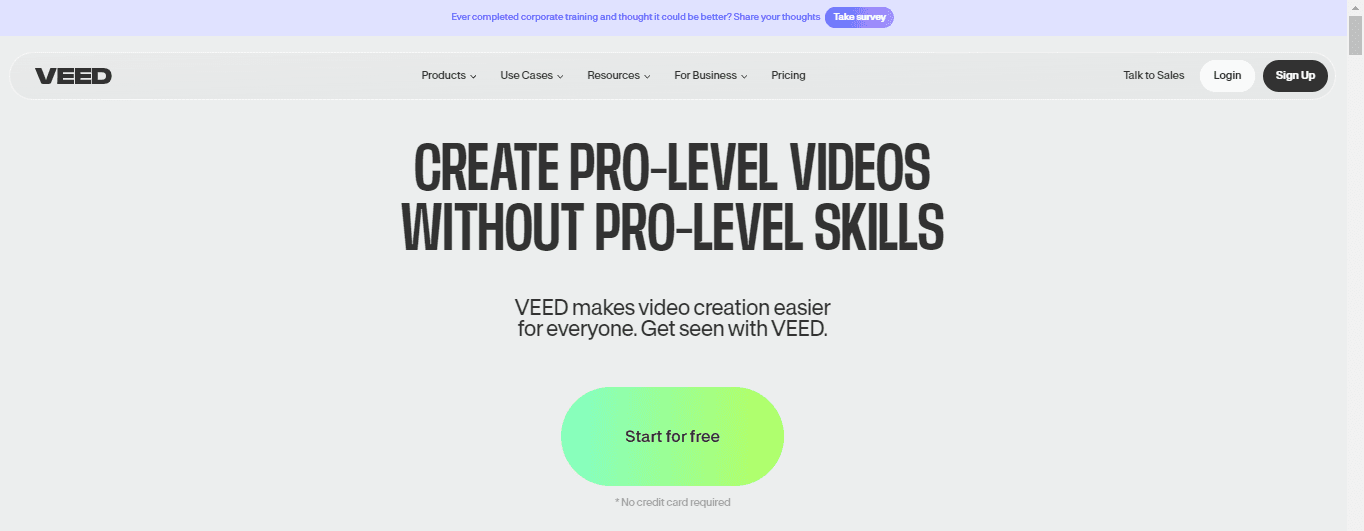
Veed.io is a web-based video editing tool with numerous features for creating professional-quality videos.
Pros
Free account available
Clean interface
Responsive
Cons
Uploading media is not intuitive
4. Adobe Premiere Rush
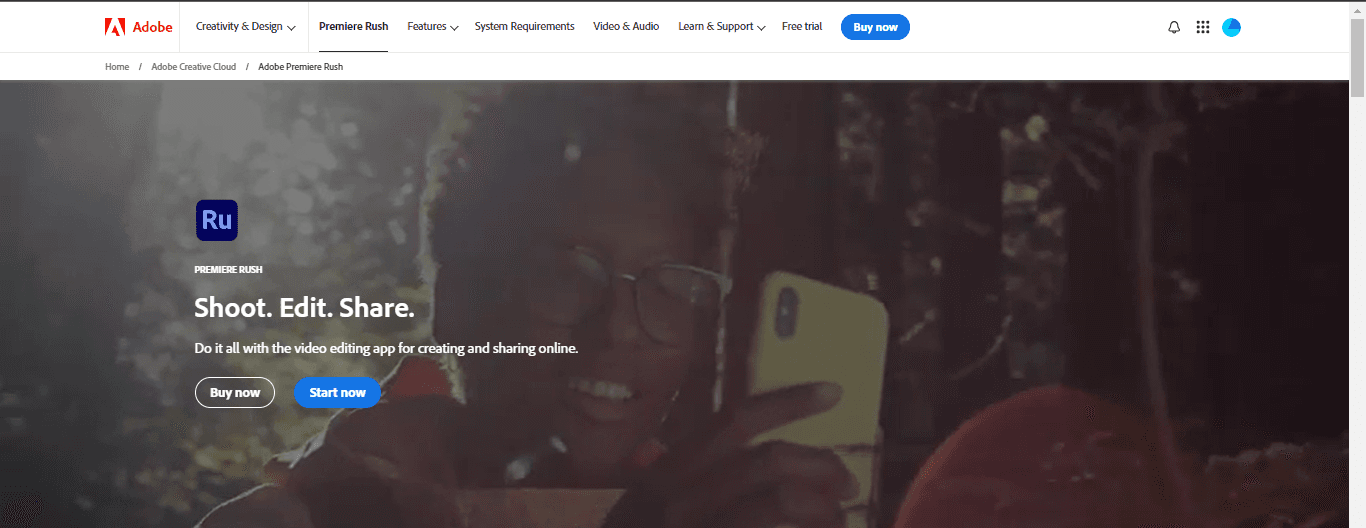
Adobe Premiere Rush is a multi-platform video editor that balances powerful tools with a simple interface.
Pros
Easy to use
Multi-platform
Lots of useful tools
Cons
Requires Creative Cloud subscription
Not all tools are available on all platforms
5. LumaFusion
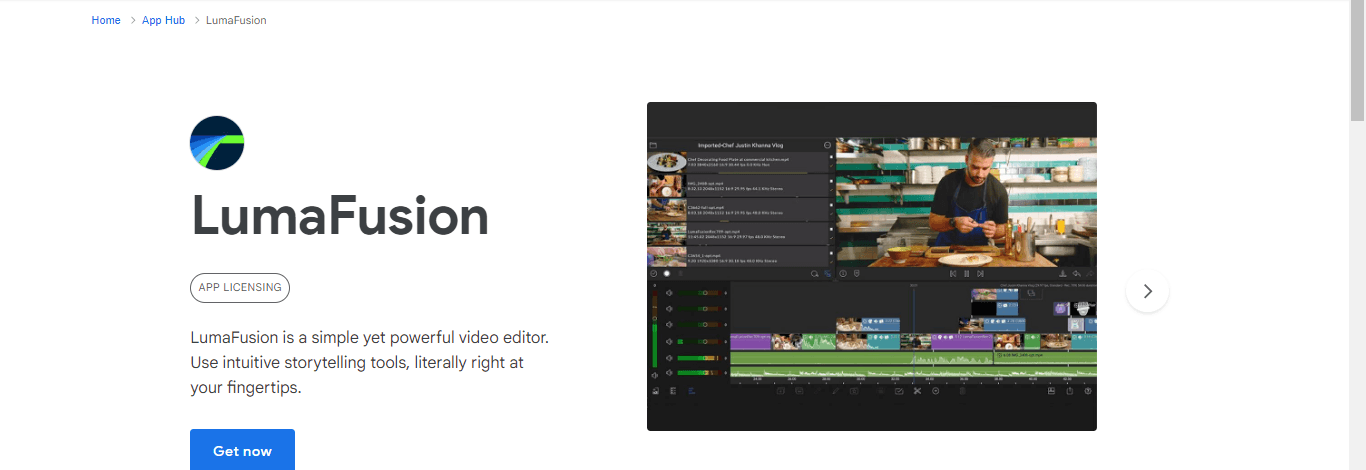
LumaFusion is a touch-based video editor for iOS and Android with an intuitive interface.
Pros
Works on iOS and Android
Looks great on tablets and mobiles
Easy to use
Cons
Occasional extra taps needed
One-off costs may not suit casual users
6. InVideo

InVideo is an AI video generator with a vast library of templates and stock features.
Pros
Access to over 1 million videos and photos
User-friendly interface
Create videos in any language
Cons
Cannot switch between templates
Exporting process can be lengthy
7. Pictory

Pictory is an excellent AI tool for creators who need to create videos quickly. Simply provide a script or article, and Pictory will make a video.
Pros
Customizable video output
Automatic captioning
Cons
The first draft needs heavy editing
8. DeepBrain AI
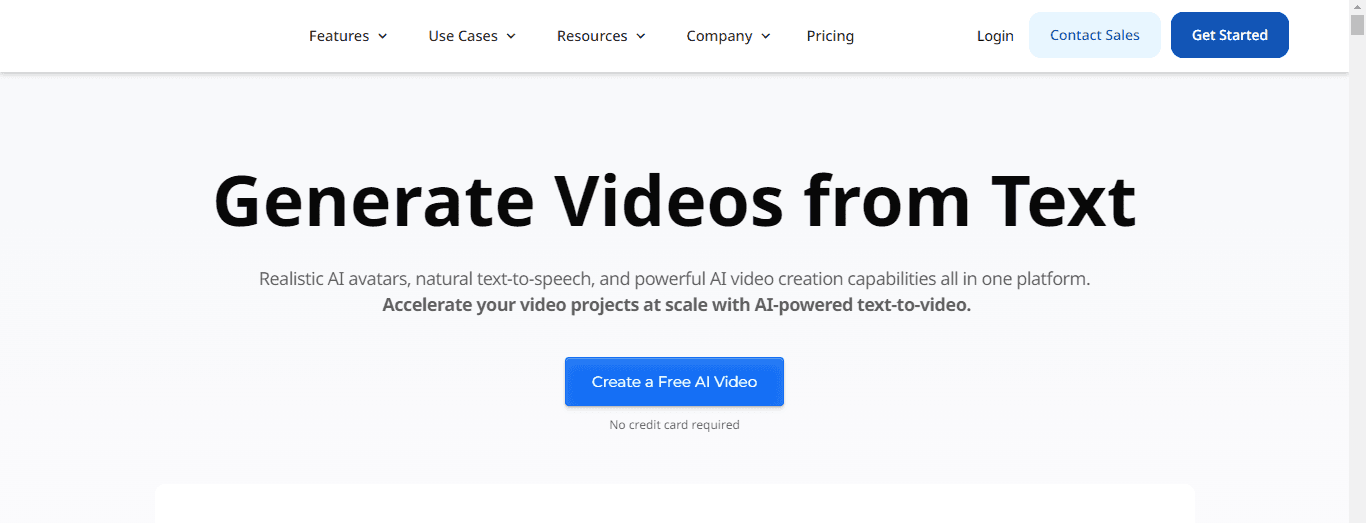
DeepBrain AI turns written content into engaging videos with over 100 AI avatars.
Pros
The large cast of AI avatars
ChatGPT integration
User-friendly interface
Cons
Cannot preview videos
Limited customization of AI models
9. Biteable
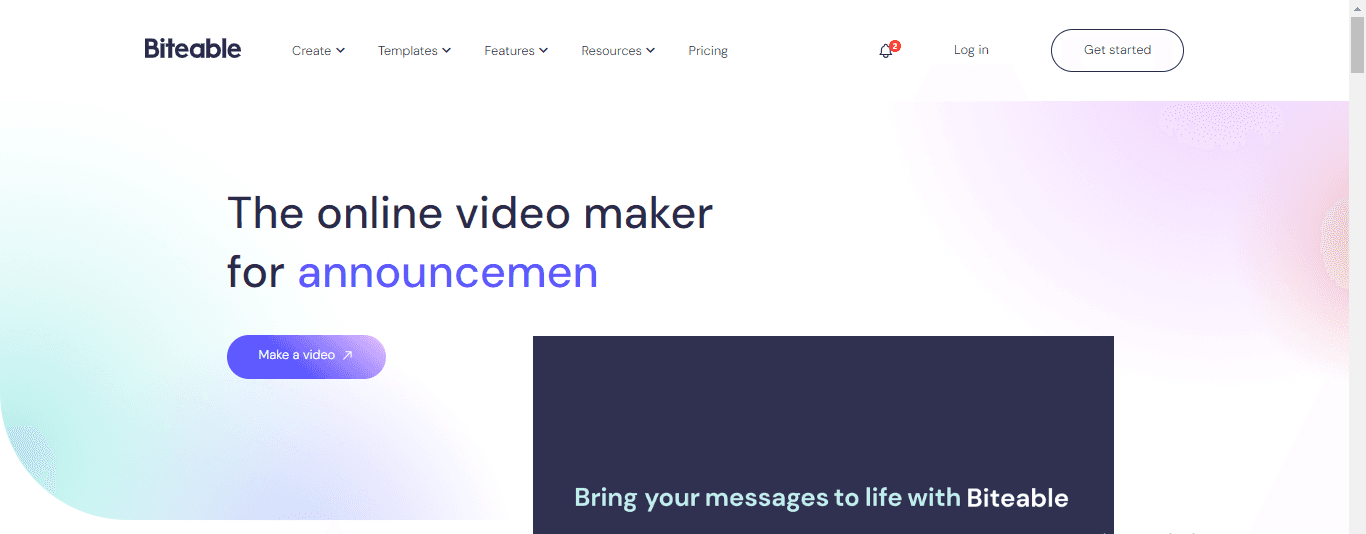
Biteable is an online video maker with simple tools and unique animated templates.
Pros
Clean interface
Easy to use
Fun, unique assets
Cons
Premium pricing
Limited browser support
10. Synthesia

Synthesia is an AI video creation platform with over 120 languages, accents, and voice tones.
Pros
No film production is needed
Large menu of avatars
Cons
Avatars lack facial expressions
Limited scalability
11. Vizard AI

Vizard AI transforms long videos into social-ready clips with AI-driven features.
Pros
User-friendly platform
Time-saving AI features
Supports multiple languages
Cons
Limited free plan
The learning curve for text-based editing
12. CapCut
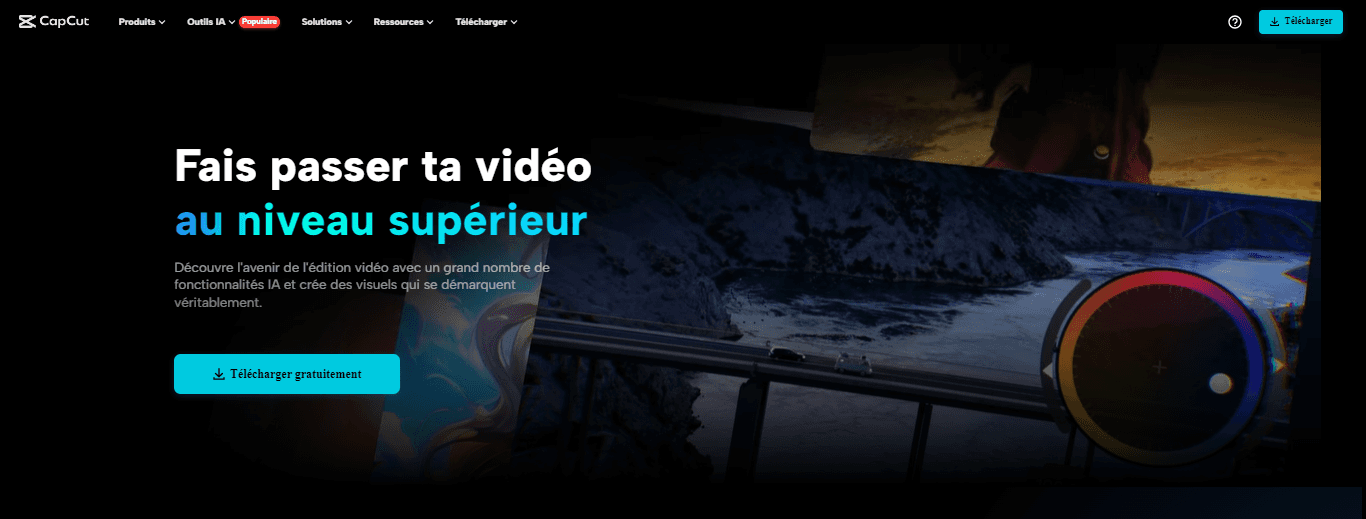
CapCut is ideal for creating content for TikTok, Instagram, or YouTube with a vast library of templates.
Pros
Quick and simple to use
A sound library of free elements
Cons
Best for social media videos
Limited effects and output formats
13. Videoleap
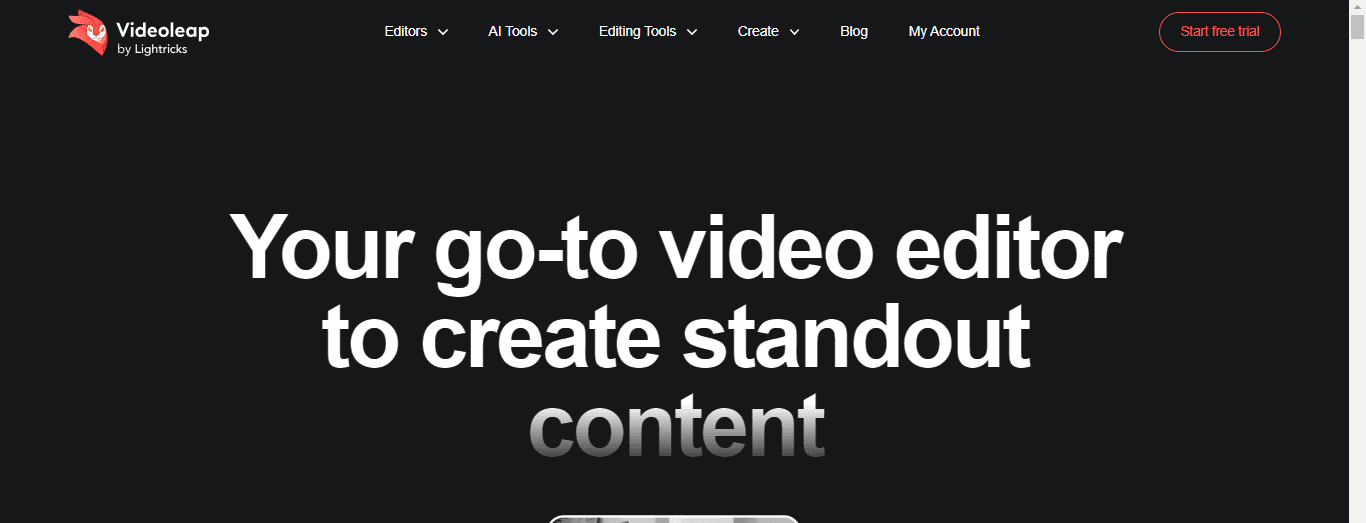
Videoleap is a video editing app loaded with AI tools and effects.
Pros
Choice of subscription or one-off cost
Simple and fun to use
Cons
Useful features paywalled
The phone only supports portrait mode
14. Animoto
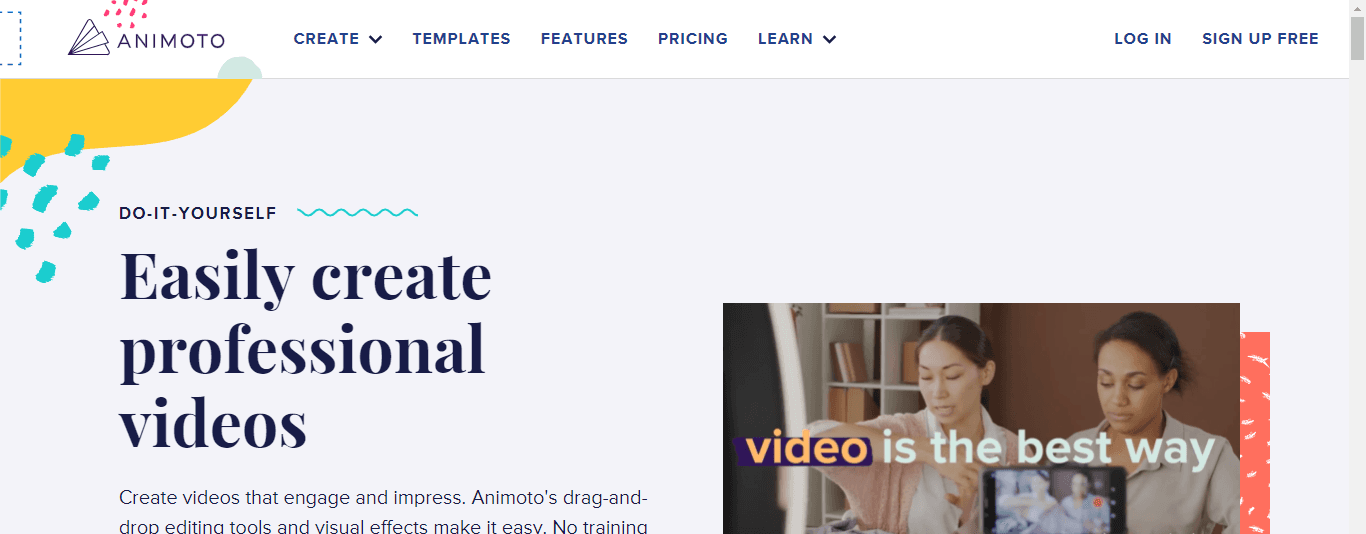
Animoto has vertical, square, and landscape video templates across social channels.
Pros
Responsive online service
Free to try (with watermark)
Cons
Basic editing tools
Restrictive interface
15. Opus Pro

Opus Pro transforms long-form videos into engaging short clips using AI-driven content transformation.
Pros
Active speaker detection
Cons
Limited language support
Costly advanced features
Related Reading
Complete 3-Step Guide On How To Create Viral Clips and Shorts In Seconds With Crayo
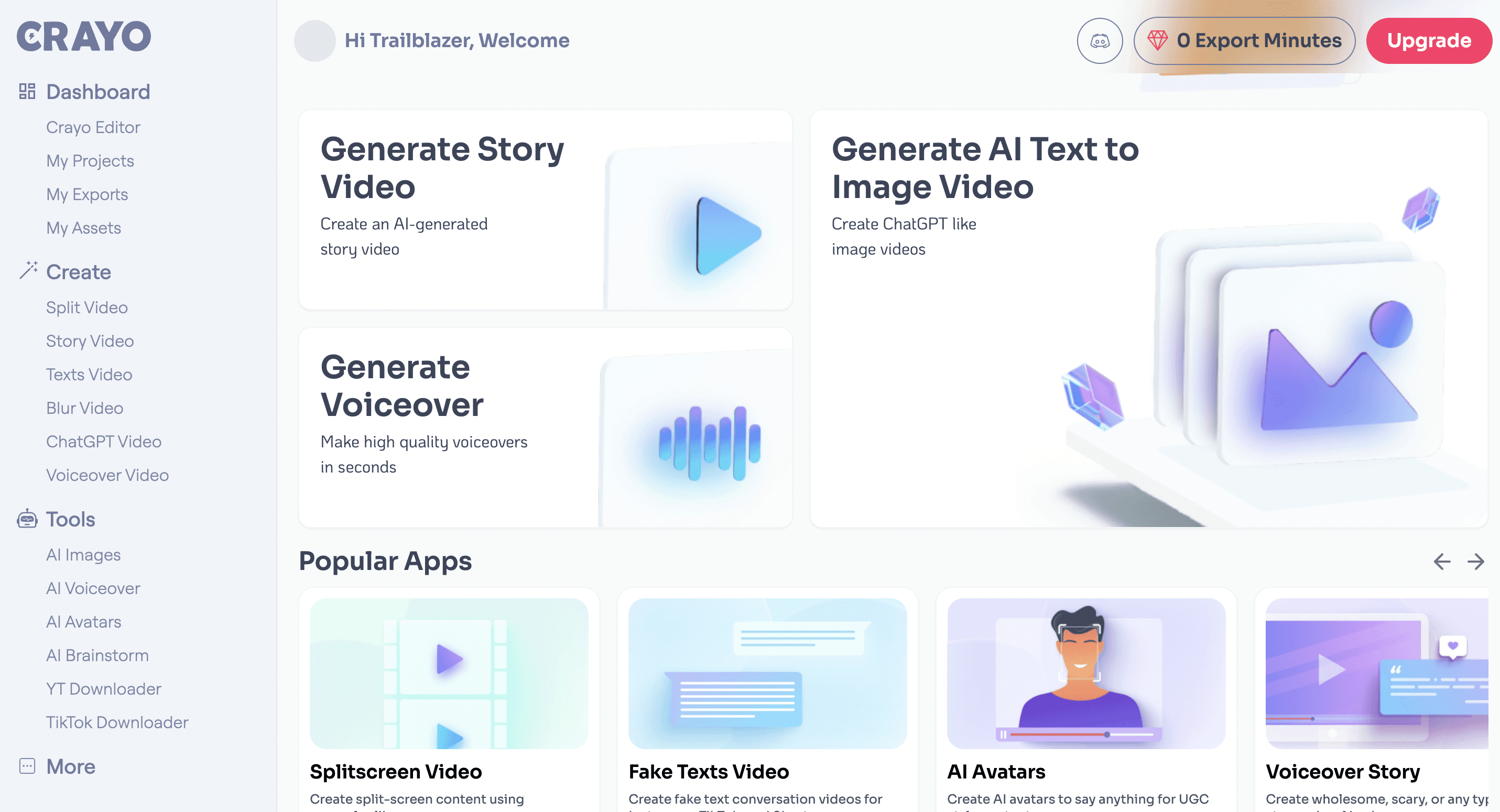
Crayo AI is your shortcut to crafting short-form videos in no time. This tool lets you churn out unlimited video content at once, auto-generating captions, effects, backgrounds, and music. With Crayo, you can jump from concept to viral footage in seconds. Just jot down an outline or prompt, pick a style, and export. It’s that simple. The Tiktok Creator Fund program can turn those viral clips into cash.
Try Crayo’s free clip creator tool today—right from the homepage, no account needed—and watch your content go viral in minutes.
Use Cases of Video Content

Boost Marketing with Video
1. Promo Videos
Capture attention with high-energy, engaging promotional videos. Use them to spotlight new products, special offers, or company milestones. These quick hits are perfect for website landing pages and social media ads.
2. Social Videos
Create short, shareable content tailored for platforms like Instagram, TikTok, and Twitter. These videos should be fun and authentic, encouraging interaction and boosting reach organically.
3. Video Case Studies
Showcase customer success stories with compelling narratives. Video case studies highlight real-world applications and results, making them powerful tools for building trust and credibility.
Capacitate Sales with Visuals
4. Product and Service Videos
Give your sales team the tools to showcase your offerings in action. These videos can demonstrate features and benefits more effectively than static content.
5. How-To Videos
Break down complex processes into simple, step-by-step guides. These are invaluable for potential clients looking to understand your products better.
6. Expert Interviews
Leverage the authority of industry leaders to build credibility. These interviews can address common pain points and offer solutions, positioning your brand as a thought leader.
7. Product Launches
Generate buzz with exciting launch videos. Showcase the new product’s features, benefits, and unique selling points in a visually appealing way.
Transform HR with Video
8. Recruitment Videos
Attract top talent with engaging, authentic stories about what it’s like to work at your company. Share these videos on career pages and social media to reach suitable candidates.
9. Training and Orientation
Streamline the onboarding process with informative videos. These can cover everything from company culture to specific role responsibilities, helping new hires hit the ground running.
10. Compliance Videos
Ensure everyone is on the same page with easy-to-follow compliance training. These videos can simplify complex regulations and make it easier for employees to understand and adhere to them.
Boost Skills and Knowledge with Educational Content
11. Educational Content
Share knowledge through informative videos. These can cover industry trends, new technologies, or best practices, helping employees stay updated.
12. Interactive Training Materials
Engage learners with interactive videos. These can include quizzes, scenarios, and branching paths to make the learning experience more engaging and effective.
Improve Internal Communication with Video
13. Virtual Meetings
Video meetings can keep remote teams connected, help maintain a sense of community, and ensure everyone is aligned on goals and priorities.
14. CEO Speeches
Share essential messages from leadership with professionally produced videos. These can be used to announce company changes, celebrate milestones, or provide updates on business performance.
15. Corporate Change Announcements
Communicate changes effectively with explicit, concise videos. These can help ensure everyone understands what’s happening and why, minimizing confusion and resistance.
Do Video Creators Make Money?

Video creators make money through ad revenue, primarily on platforms that support ad sharing. YouTube’s Partner Program is a standout example. Creators earn money by allowing ads to run on their videos. How much they make depends on factors like video views, the types of ads, and how viewers engage with them. Other platforms, including Facebook, TikTok, and Twitch, offer similar programs but with distinct requirements and revenue-sharing models.
The Lucrative World of Sponsorships and Brand Deals
Partnering with brands can be incredibly profitable for video creators. Companies pay them to showcase their products or services within their content. These sponsorships can be particularly lucrative for creators with large and engaged followings.
Boosting Income with Affiliate Marketing
Affiliate marketing is another avenue where creators can earn. They promote products or services and provide their audience with unique affiliate links. Whenever a viewer purchases using that link, the creator earns a commission. This method can be highly effective if a creator’s audience trusts their recommendations.
Making Money Through Merchandise Sales
Many video creators design and sell their merchandise. Platforms like Teespring or Shopify make it easy for creators to sell custom products such as t-shirts and mugs. Merchandise not only helps generate extra income but also helps build a creator’s brand.
Crowdfunding and Donations: Fans Supporting Creators
Platforms like Patreon allow fans to support creators directly by subscribing to exclusive content or perks. Viewers can donate to creators during streams on live-streaming platforms like Twitch, providing another revenue stream.
Courses and Digital Products: Monetizing Expertise
Creators often leverage their knowledge to make money by selling digital products, such as e-books, online courses, or tutorial videos. This approach allows creators to monetize their expertise and provide value to their audience.
Licensing Content for Passive Income
Creators can also license their videos or footage. This means allowing other entities, such as commercials or TV shows, to use their content for a fee. Licensing can provide substantial passive income.
Fan Subscriptions: A Steady Revenue Source
Many platforms offer fan subscription programs. Viewers can subscribe to their favorite creators’ channels for free to access exclusive content or perks, helping creators earn a steady income.
Curious about how to boost your content game? Try Crayo’s free clip creator tool today. It's the quickest way to morph ideas into viral short videos. Click the ‘Try Now’ button on our homepage to start. No account is required!
Create Viral Shorts In Seconds With Crayo
Could you transform your ideas into a short video with just a few clicks? Enter Crayo AI, the tool designed to take the heavy lifting out of content creation. In the fast-paced world of video content, speed and efficiency are crucial. That’s where Crayo AI lets you create unlimited short videos simultaneously. It even auto-generates captions, effects, backgrounds, and music. With this tool, you can focus on your creativity while Crayo handles the technical stuff.
Maximize Earnings with TikTok’s Creator Fund
Crayo isn’t just about making your life easier — it’s about opening new revenue streams. The TikTok creator fund program rewards creativity, and with Crayo, you can produce more content faster, increasing your chances of going viral and getting paid. Consider turning your ideas into multiple short videos in seconds. You’re not just producing content but maximizing your earning potential with every piece you create.
Smooth Workflow: Idea to Video in Seconds
Crayo’s process is simple: Write an outline or prompt, customize the style with backgrounds, voices, and music from Crayo’s free templates, then finish and export. It’s all about efficiency without sacrificing quality. You don’t need to be a video editing pro to create professional-grade content. Whether you’re an experienced creator or just starting, Crayo makes it easy to produce engaging videos quickly.
Instant Access to the Crayo Experience
Ready to start creating? Crayo offers a free clip creator tool requiring no account to start. Just click the ‘Try Now’ button on the homepage, and you’re immediately on your way to crafting videos that could become the next big thing. Why wait? Explore the possibilities with Crayo and see how easy it is to bring your ideas to life.


